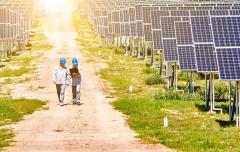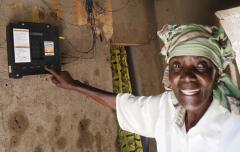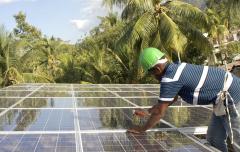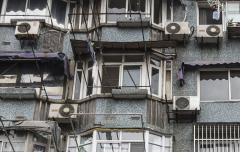SEforALL Analysis of SDG7 Progress - 2024
Utilizing the latest data from the Tracking SDG7: The Energy Progress Report 2024, SEforALL has conducted a deep-dive analysis to provide a snapshot of the world’s current situation across the four targets of SDG7: electricity access (7.1.1), clean cooking access (7.1.2), renewable energy (7.2) and energy efficiency (7.3). This analysis builds on the Tracking SDG7 Report with an additional perspective on regions and high-impact countries.
The trend of reducing unelectrified population was reversed for the first time.
The 2021 data of Renewable energy share in Total Final Energy Consumption (TFEC) also showed a setback from the previous year.
Much more needs to be done for increasing efficiency and clean cooking access.
DATA SOURCES: IEA, IRENA, UNSD, World Bank, and WHO (2024) Tracking SDG7 2024 Report and its Datasets
Overall progress
The trend of reducing unelectrified population was reversed for the first time in 2022
The number of global unelectrified population was reduced from 1.14 billion in 2010 to 685 million in 2022 but increased 10 million from 2021.
8 million out of the 10 million increase from 2021 to 2022 came from Asia, although the region reduced unelectrified population from 516 million in 2010 to 77 million in 2022. Meanwhile, Africa as a whole has stayed the same level of unelectrified population (591 million) during the same period with rapidly increasing population. 20 African countries increased unelectrified population from 2010.
Countries that are backsliding or made no material changes should have robust tailor-made country strategies and their swift implementation, taking an account of the persistent differences in rural and urban electrification, to achieve universal access by 2030.
Population without clean cooking access has reduced but shows slow improvement.
There are currently 2.1 billion people without access to clean fuels and technologies for cooking with 50% of them in Asia and 45% in Africa. 75% of the people without access live in just 20 countries with 9 of them in Asia and the remaining 11 in Africa.
All top 20 access deficit countries have more than 20 million domestic population without access. While Asia must provide access to a larger number of population by 2030, Africa’s 170 million increase of population without access since 2010 necessitates significant growth of access rate improvement, particularly considering the continent’s expected population growth.
The 2021 data of RE share in Total Final Energy Consumption (TFEC) also showed a setback from the previous year
Regionally, Oceania is the only region that RE share in TFEC progressed from 2020, while Asia had no changes. All other regions show setbacks. The world share of modern renewables in total energy consumption did not change from the previous year, staying at 12.5%
The decline of international public financial flows in support of renewable and clean energy showed a comeback in 2022. However, the 2022 investment total was just 54% of the 2016 amount and need to be fortified further
Energy efficiency improvement has been continuously slow
A continuing decline in the pace of progress on energy efficiency since 2015 still persists. The annual average improvement rate between 2010 and 2021 is down to 1.6%, far from the originally targeted 2.6%. The 2021 annual improvement rate was mere 0.8%, 0.2 percentage point up from the previous year data but still very low. This makes achieving SDG 7.3 target very difficult.
Both Africa and Asia remain higher energy intensity than the world average and their progress is slow. Focus on these two regions as well as countries with higher energy intensity in the top 20 energy consuming countries can be effective.
Based on the current trends, we will still have around 660 million unelectrified people by 2030 (SDG 7.1.1)
A current trend projection and the IEA’s stated policy scenario analysis show that 660-663 million people will remain unelectrified in 2030.
Countries with large unelectrified populations, low electrification rates, negative changes (increased unelectrified population and / or reversed electrification rates), or no material changes in the past few years need to be identified and the efforts to electrify need to be strengthened.
Additionally, countries with the smaller number of unelectrified populations but low electrification rates also need immediate country actions based on sound strategies to leave no one behind. The strongest policy and investment focus need to be continuously on Sub-Saharan Africa.
Based on the current trends, 1.8-2.0 billion people do not have clean cooking access in 2030 (SDG 7.1.2)
Projections show that we are not on track to achieve universal access to clean fuels and technologies for cooking by 2030, with approximately 1.8 to 2.0 billion people expected to remain without clean cooking access based on current trends
Although countries with large population without access can be prioritized for higher impacts on global SDG7.1.2 achievement, those show negative changes (increased population without access and / or reversed access rates) or no material changes, along with countries with very low access rates and countries with low improvement rates, all need tailor-made strategies and their rapid implementation.
Based on the current trends, renewable energy will have only modest increase by 2030, far below to achieve net zero by 2050.
The share of renewables in TFEC is projected to increase to only around 21-23% by 2030. While the IEA projection has not changed from the previous year estimate, the 2021 setback lower the straight-line trend projection.
Africa's modern RE stays around 15% of total RE share without strong advancement, while all other regional have above 60% of total RE shares come from modern RE. Modern RE, electrification and clean cooking accesses should be pushed together in Africa to change this situation.
Based on recent data, an energy intensity improvement rate of at least 3.8 percent per year from now through to 2030 will be necessary to achieve SDG 7.3
With the continuous slowdown in the rate of improvement of energy intensity, the efforts to reach SDG 7.3 is increasing every year. The differences between the actual improvement rate and target rate get bigger and bigger.
All end-use sectors (industry, transport and building) need to be incentivized to be more energy efficient with more investment and better enabling policies and regulations. In-depth analysis of sector specific energy intensity for each country is important to create sound and targeted and effective strategies, considering wide diversity of economic structure and climatic conditions.
Access to electricity
The year 2022 was the first year that the number of unelectrified people has increased from the previous year. While Africa is becoming the sole region with the majority (86%) of unelectrified population, the remaining Asia seems struggling last-mile electrification.
80% of the unelectrified people live in just 24 countries (20 of them in Africa and the remaining 4 in Asia). This has not changed from 2021.
96% of the global improvement since 2010 has been driven by gains in Asia, particularly in India and Bangladesh (62% and 14% gains, respectively). Meanwhile, India and Pakistan have been struggling to close last-mile electrification, and some Asian countries (e.g., Afghanistan, Yemen) which are not in the top 24 list of the number of unelectrified population show backsliding in access rates in 2022.
Africa’s gain in electricity access rate has been 15 percentage points, from 44% to 59%, since 2010. However, with significant population growth, the 2022 unelectrified population has remained the same number with 2010 (591 million).
The countries with negative changes (increased unelectrified population and / or reversed electrification rates) or no material changes need to be identified and the efforts to electrify need to be strengthened.
There were ~685 million people in the world without access to electricity as of 2022
Population without electricity access, millions, 2022
DATA SOURCES: IEA, IRENA, UNSD, World Bank, WHO (2024) Tracking SDG7 2024 Report Datasets
Looking forward, based on the current trends, we are not on track to achieve SDG 7.1.1 by 2030
A current trend projection and the IEA’s scenario analysis show that we are not on track to achieve universal electricity access by 2030, as 660-663 million people are expected to remain unelectrified in 2030
We need much stronger and tailor-made actions and investments, particularly for many in Africa, but also for Asia’s last mile electrification.
Regardless the improvement rates since 2010 and the current size of unelectrified populations, all countries with total access rates below 50-60% need more and accelerating efforts. 14 African countries in top 24 deficit countries have less than 50% access rates.
80% of the unelectrified people live in just 24 countries (20 of them in Africa and the remaining 4 in Asia). This has not changed from 2021.
24 countries make up 80% of the electrification challenge, 2022
DATA SOURCES: IEA, IRENA, UNSD, World Bank, WHO (2024) Tracking SDG7 2024 Report Datasets
Even countries with relatively high rate of access (above 60-65%) still require continuous tailor-made efforts for both urban and rural populations to cross the goal line by 2030. Persistent differences in the rural and urban electrification rates in both Asia and Africa demand different approaches to close the gap in each region.
Asian countries in top 24 unelectrified population country list have close to 100% urban electrification rates and high rural electrification rates, except DPR Korea. Last mile rural electrification efforts needs to be implemented with strong determination in these countries.
Sub-Saharan Africa has 81% urban electrification rate, not changed from 2021, and rural electrification rates of just over 34%, decreasing from 37% in 2021. The slow progress in both urban and rural areas need to be changed with focused efforts for last-mile electrification of urban area and stronger rollout of large-scale rural electrification programs.
Both Asia and Africa needs strong rural push, while most African countries also needs urban electrification progress including last-mile schemes
Rural vs Urban electrification rates 2022
DATA SOURCES: IEA, IRENA, UNSD, World Bank, WHO (2024) Tracking SDG7 2024 Report Datasets
2022 was the first year that total unelectrified population increased from the previous year since 2010. Both Asia and Africa increased the numbers.
Population without electricity access, millions, 2010-2022
DATA SOURCES: IEA, IRENA, UNSD, World Bank, WHO (2024) Tracking SDG7 2024 Report Datasets
Reduction in unelectrified population between 2010 and 2022
NOTE: These figures represent the absolute change in the number of unelectrified people between 2010 and 2022 and does not account for changes in the population due to birth rates, human migration etc.
DATA SOURCES: IEA, IRENA, UNSD, World Bank, WHO (2024) Tracking SDG7 2024 Report Datasets
14 African countries in top 24 access deficit countries have less than 50% access rates
2022 Population without access vs Changes in population without access and in electricity access rates between 2017 and 2022 (Top 24 African Access Deficit countries )
DATA SOURCES: IEA, IRENA, UNSD, World Bank, WHO (2024) Tracking SDG7 2024 Report Datasets
28 out of 29 African countries that are not in Top 24 access deficit county list improved access rates since 2017.
2022 Population without access vs Changes in population without access and in electricity access rates between 2017 and 2022 (non-Top 24 African Access Deficit countries)
DATA SOURCES: IEA, IRENA, UNSD, World Bank, WHO (2024) Tracking SDG7 2024 Report Datasets
Access to clean cooking
Population without access to clean fuels and technologies for cooking by region, millions, 2022
DATA SOURCES: IEA, IRENA, UNSD, World Bank, WHO (2024) Tracking SDG7 2024 Report Datasets; World Bank Total Population data 2024
NOTE: Due to lack of access rate data for various countries in the 2024 dataset as well as the possible data disparity of total population data used, there is 18 million difference between the population calculated without access using the world access rate (2100 million) in the report and the sum of all countries population without clean cooking access of individual countries and regions (2082 million) calculated by the datasets. This creates the sum of the shares of each region only adds up to 99.1%. The 2024 Tracking SDG7 dataset and the World Bank Total Population dataset updated on June 28, 2024, were used for calculation.
The global average annual reduction rate of the population without clean cooking access since 2010 is only 2.5%, just 0.1 percentage point increase from last year.
- Asia’s progress is stronger than other regions with annual improvement rate of 5.6% since 2010. The population without access has declined from 2.1 billion to 1.0 billion in the region. While 23 Asian countries reduce the population without access, 14 countries went backward since 2010.
- The number of population without clean cooking access in Africa has increased by 170 million (from ~776 million to ~946 million) since 2010, with annual average growth rate of 1.7% (increase of 0.1 percentage point from the 2010-2021 average). 39 African countries increased the numbers of population without access since 2010, three times more than 13 countries that reduced the numbers.
Looking forward, based on the current trends, we are not on track to achieve SDG 7.1.2 by 2030
- A current trend projection and the IEA’s scenario analysis show that we are not on track to achieve universal access to clean fuels and technologies for cooking by 2030, as between 1.8 and 2.0 billion people are expected to remain without clean cooking access
- India, China, Indonesia, Nigeria, Pakistan and Ethiopia, will remain with more than 100 million population without clean cooking access, and all other top 20 access deficit countries will also have more than 20 million population without access. These countries can be prioritized for higher impacts on global SDG7.1.2 achievement. Regardless the size of total population and population without access, however, countries with very low access rates and countries with low improvement rates need more attentions to accelerate the rate of improvement.
- While the current annual global investment in clean cooking access is around 2.5 billion USD, this needs to be increased 3.2-fold to 8 billion USD annually by 2030 to achieve SDG7.1.2, according to the IEA.
- Electric cooking can be an option for solving both electricity and clean cooking access for 14 of high access deficit countries in both areas. However, it is not an easy task as well-coordinated planning accompanied with enabling policy and regulatory measures, realistic projects, and support investments are needed to provide higher Tiers of electricity access for cooking and increased affordability.
Top 20 access deficit countries are in Africa and Asia, making up 75% of the access to clean cooking challenge
DATA SOURCES: IEA, IRENA, UNSD, World Bank, WHO (2024) Tracking SDG7 2024 Report Datasets; World Bank Total Population data 2024
Population without access to clean fuels and technologies for cooking by region, millions, 2010-2022
NOTE: The World Bank / ESMAP historical data up to 2021 and the total population historical data were both updated with the 2024 dataset. This creates inconsistencies with the analysis in the previous year.
DATA SOURCES: IEA, IRENA, UNSD, World Bank, WHO (2024) Tracking SDG7 2024 Report Datasets; World Bank Total Population data 2024
Reduction in population without access to clean cooking between 2010 and 2022, millions
DATA SOURCES: IEA, IRENA, UNSD, World Bank, WHO (2024) Tracking SDG7 2024 Report Datasets; World Bank Total Population data 2024
14 countries make up both of the top 80% of electricity access and 71% of clean cooking access challenge
DATA SOURCE: IEA, IRENA, UNSD, World Bank, WHO (2024) Tracking SDG7 2024 Report & its Datasets
While significant overlaps are found between lack of electrification and clean cooking, the large difference of population numbers without access between the two and other factors show that lower tier electricity access does not automatically contribute to clean cooking access as a fuel.
There is a correlation between electrification and access to clean cooking, but the difference in population without access in the two areas are large
Clean cooking technologies (such as solar cookers) can be used as an entry product to unelectrified households, and e-cooking solution may create synergy between electrification and clean cooking access.
In reality, however, e-cooking affordability, cooking traditions, and level of electricity access are some of the factors need to be overcome to create the synergy between the two energy accesses.
- Tier 1 or 2 electricity access does not provide enough power for electric cooking, and efficiency plays an important role.
- In many parts of the world, electricity is not an affordable clean cooking fuel compared to traditional fuels.
- Electric cooking stoves could be also expensive and difficult to obtain due to weak local market demand and/or lack of local industry/supply.
- Many people have strong fuel preferences on their cultural cooking practices.
To create synergy between electricity and clean cooking accesses through e-cooking, well-coordinated planning, policy and regulations based on the nature of market failures and more funding to multi-benefit projects may be needed.
Share of renewables in Total Final Energy Consumption (TFEC)
The share of renewables, including the use of traditional biomass, in total final energy consumption (TFEC) was 18.7% in 2021, receding for the first time since 2010. The world share of modern renewables in total energy consumption stayed at 12.5%.
- The increase of global share of renewables in its total final energy consumption (TFEC) in 2021 was 2.7 percentage point from 16.0% in 2010, while the increase of the share of modern renewables in 2021 was 3.8 percentage points from 8.7% in 2010.
- Regionally, Oceania is the only region that progressed from 2020 in RE share in TFEC, while Asia had no changes. All other regions showed setbacks.
- As for Modern RE share, Africa, Asia and Oceania has increased the shares, Lartin America and the Caribbean and North America and Europe reduced their shares from 2020. Africa's modern renewable share stays around 15% of RE consumption without strong advancement, while all other regions have above 60% of modern sources among RE shares.
- In terms of RE power generating capacity per capita, Asia made strong progress since 2010, exceeding developed countries’ average growth rate, while Sub-Saharan Africa (SSA) and Least Developed Countries (LDCs, many in SSA) have much smaller growth rates following the slow pace of electrification.
International public investment in renewables to developing countries bounced back in 2022.
- The decline of international public financial flows in support of renewable and clean energy hit bottom in 2019, 2020 and 2021, and showed a comeback in 2022. However, the 2022 investment total was just 54% of the 2016 amount.
- Global total investment in renewables has been increasing but the 2023 amount is still only three-quarter of what is needed to achieve net zero by 2050. More than 80% of the total investment remains concentrated in advanced economies and China.
Looking forward, based on the current trends, we are not on track to achieve SDG 7.1.2 by 2030
- The share of renewables in TFEC is projected to increase to only around 21-23% by 2030. While the IEA projection has not changed from the previous year estimate, the 2021 setback lower the straight-line trend projection.
- The IEA estimates that modern uses of renewables would represent just over a third of TFEC in 2030 under its the Net Zero Emissions by 2050 scenario. To achieve this level of share, modern RE needs to be accelerated further, particularly in Africa.
- Global RE heat consumption is progressing very slowly, while RE consumption in electricity has much higher annual average growth rates since 2010. Transport RE consumption is growing strongly but it needs make up for an extremely low starting point. All the growth trends in heat, electricity and transport have strong variations among regions.
Today, the share of renewables in the energy consumption is 18.7%, 12.5% of which is modern renewables. In 2021, SDG7.2 saw a setback for the first time since 2010
Share of renewables in total energy consumption, % 2010-2021
DATA SOURCES: IEA, IRENA, UNSD, World Bank, WHO (2024) Tracking SDG7 2024 Report Datasets
Share of renewables in energy consumption by region, %, 2010, 2021
DATA SOURCES: IEA, IRENA, UNSD, World Bank, WHO (2024) Tracking SDG7 2024 Report Datasets
Only 17.2% of energy consumption of the top 20 energy-consuming countries are from renewables, 0.4 percentage point down from 2020
Share of renewables and TFEC in top 20 energy consuming countries (2021)
DATA SOURCES: IEA, IRENA, UNSD, World Bank, WHO (2024) Tracking SDG7 2024 Report Datasets
Energy intensity
The world used 4.6 MJ (megajoules) of energy to generate USD 1 of economic activity in 2021, unchanged since 2020
- Africa (5.3 MJ/USD GDP) and Asia (5.0 MJ/USD GDP) remained more energy intensive than the world average with slow progress.
- Latin America & the Caribbean is the least energy intensive region with 3.4 MJ/USD GDP, but it increased 0.1 MJ/USD from 2020. It is followed by North America and Europe (4.0 MJ/USD GDP) and Oceania (4.1 MJ/USD GDP). Both regions reduced their intensity slightly.
- Of top 20 most energy consuming countries:
- 13 countries have lower energy intensity than the group average, but 5 countries increased energy intensity from 2020.
- 10 are more efficient than the world average, with the United Kingdom, Germany and the United States leading the way.
- 16 countries have improved their energy intensity since 2017.
This calls for focusing on countries in this top 20 energy consuming group that have higher energy intensity and/or low improvement rate.
The global energy intensity has decreased from 5.5 MJ/USD GDP in 2010 to 4.6 MJ/USD GDP in 2021, but the average annual rate of improvement of 1.6% between 2010 and 2021 was lower than that between 2010 and 2016.
- The rates of improvement have significantly slowed down in the recent years. The 0.8% annual improvement from 2020 to 2021 was the second lowest since 2010 and remains well below SDG 7.3 targets.
- Global end-use energy efficiency investment decreased 6% from 2022. In 2023, the world invested only around 70% of the annual amount required to meet the SDG7.3 under the IEA’s Net Zero Emissions by 2050 Scenario (USD 566 billion per year (2022 USD))
We will need an energy intensity improvement rate of at least 3.8 percent per year through 2030 to achieve SDG 7.3
- Due to the slowdown in the rate of improvement of energy intensity since 2015, reaching SDG 7.3 will require much higher improvement rate than the originally rate of 2.6%. The estimate by the IEA’s scenario analysis showed that we need 3.8% of annual improvement rate between 2022 and 2030 to achieve SDG7.3, due to the slow progress between 2020 and 2021
- All end-use sectors (industry, transport and building) need to be incentivized to be more energy efficient with more investment and better enabling policies and regulations. In-depth analysis of sector specific energy intensity for each country is important to create sound and targeted and effective strategies, considering wide diversity of economic structure and climatic conditions.
Energy intensity by region, MJ/USD 2017 ppp, 2020 and 2021
DATA SOURCES: IEA, IRENA, UNSD, World Bank, WHO (2024) Tracking SDG7 2024 Report Datasets
13 of top 20 energy consumption countries have energy intensity lower than the world average
Energy intensity and TFEC in top 20 energy consuming countries (2021)
DATA SOURCES: IEA, IRENA, UNSD, World Bank, WHO (2024) Tracking SDG7 2024 Report Datasets
Growth of Energy Intensity and GDP of Top 20 Energy Consuming Countries, 2016-2021
DATA SOURCES: IEA, IRENA, UNSD, World Bank, WHO (2024) Tracking SDG7 2024 Report Datasets
An energy intensity improvement rate of at least 3.8 percent per year through 2030 will be needed to achieve SDG 7.3
Energy Intensity Annual Reduction Rate (%), Historical and Forecasted
NOTE: The World Bank/ESMAP historical data up to 2020 were also updated with the 2024 dataset. This creates inconsistencies with the analysis from the previous year.
DATA SOURCES: IEA, IRENA, UNSD, World Bank, WHO (2024) Tracking SDG7 2024 Report & its Datasets; IEA World Energy Outlook (2023)



